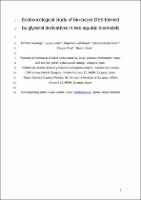Por favor, use este identificador para citar o enlazar este ítem:
https://repositorio.usj.es/handle/123456789/1067
Registro completo de metadatos
| Campo DC | Valor | Lengua/Idioma |
|---|---|---|
| dc.contributor.author | Garralaga, Pilar | - |
| dc.contributor.author | Lomba Eraso, Laura | - |
| dc.contributor.author | Leal-Duaso, Alejandro | - |
| dc.contributor.author | Gracia-Barberán, Sara | - |
| dc.contributor.author | Pires, Elisabet | - |
| dc.contributor.author | Giner, Beatriz | - |
| dc.date.accessioned | 2024-01-24T15:34:01Z | - |
| dc.date.available | 2024-01-24T15:34:01Z | - |
| dc.date.issued | 2022-06-20 | - |
| dc.identifier.citation | M. P. Garralaga, L. Lomba, A. Leal-Duaso, S. Gracia-Barberán, E. Pires and B. Giner, Green Chem., 2022, 24, 5228 DOI: 10.1039/D2GC01293F | en_US |
| dc.identifier.issn | 1463-9270 | en_US |
| dc.identifier.uri | https://repositorio.usj.es/handle/123456789/1067 | - |
| dc.description.abstract | The growing environmental impact of non-renewable solvents has generated an increasing interest in the development of more sustainable alternatives. Among these options, deep eutectic solvents (DES) are attracting great interest. The favourable physicochemical properties of these solvents make them a potential green alternative for several applications. However, its toxicological impact has not been studied enough to assume the absence of environmental risk. With the main purpose of establishing an initial overview of the aquatic toxicity, an acute ecotoxicity test of different eutectic solvents, composed of glycerol or glycerol-derived ethers and choline chloride (ChCl) or N,N,N-triethyl-N-(2,3-dihydroxypropyl)ammonium chloride (N00Cl), has been carried out in two aquatic biomodels: Aliivibrio fischeri (bacteria) and Raphidocelis subcapitata (algae). Furthermore, the content of chlorophyll was measured to observe the disruption of the photosynthetic process by the tested compounds. A dose-effect correlation has been observed, although very high concentrations of the solvents were necessary for the onset of the toxic effect. The toxicity of the DES, within the ChCl case, turned out to be greatly related to the polarizability and hydrophobicity of the solvents. Whereas N00Cl-based DES have shown an even–odd trend, compounds with even carbon numbers in the ether radical show lower toxicity than odd ones. These preliminary results point out a favourable eco-toxicological behaviour of glycerol derived DES, although studies in other bioindicators, as well as in cells and biodegradability tests are recommended in order to have a complete overview of the toxicological profiles of these promising solvents. | en_US |
| dc.format.extent | 30 p. | en_US |
| dc.format.mimetype | application/pdf | en_US |
| dc.language.iso | eng | en_US |
| dc.publisher | Royal Society of Chemistry | en_US |
| dc.relation.requires | Adobe PDF | en_US |
| dc.rights | Attribution-NonCommercial-NoDerivatives 4.0 Internacional | * |
| dc.rights.uri | http://creativecommons.org/licenses/by-nc-nd/4.0/ | * |
| dc.subject | Deep eutectic solvents (DES) | en_US |
| dc.subject | Aliivibrio fischeri | en_US |
| dc.subject | Raphidocelis subcapitata | en_US |
| dc.subject | Toxic effect | en_US |
| dc.subject | Dose-response relationship | en_US |
| dc.subject | Green solvents | en_US |
| dc.subject | Glycerol | en_US |
| dc.title | Ecotoxicological study of bio-based deep eutectic solvents formed by glycerol derivatives in two aquatic biomodels (Versión aceptada) | en_US |
| dc.type | journal article | es_ES |
| dc.relation.publisherversion | https://pubs.rsc.org/en/Content/ArticleLanding/2022/GC/D2GC01293F | en_US |
| dc.identifier.publicationfirstpage | 1 | en_US |
| dc.identifier.publicationlastpage | 30 | en_US |
| dc.identifier.doi | https://doi.org/10.1039/D2GC01293F | en_US |
| dc.rights.accessRights | open access | es_ES |
| dc.type.hasVersion | AM | es_ES |
| Aparece en las colecciones: | Artículos de revistas | |
Ficheros en este ítem:
| Fichero | Descripción | Tamaño | Formato | |
|---|---|---|---|---|
| Ecotoxicological study Version aceptada.pdf | 867,6 kB | Adobe PDF |  Visualizar/Abrir |
Este ítem está sujeto a una licencia Creative Commons Licencia Creative Commons

